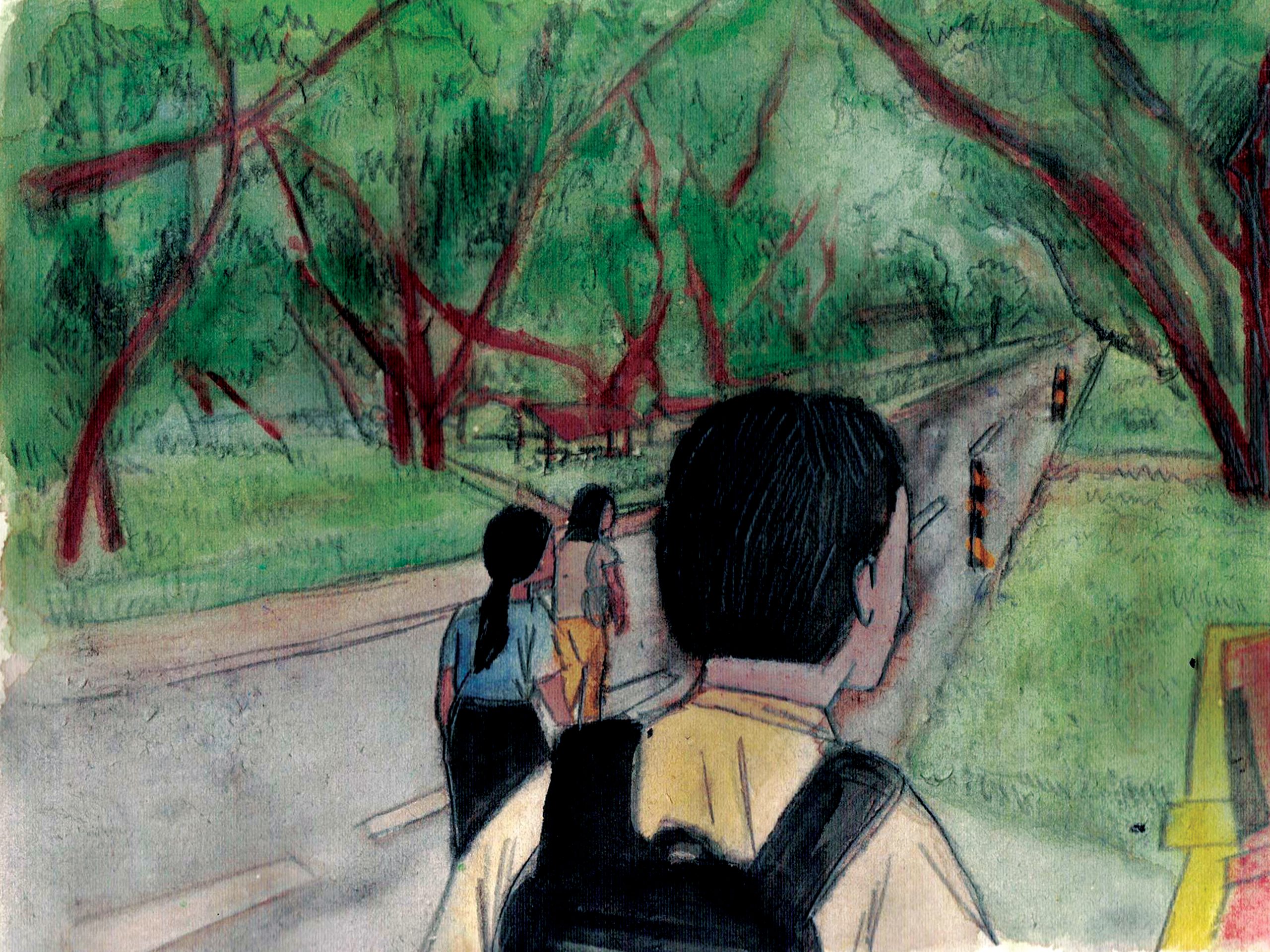Experiencing University life off-screen
Originally published in HF Volume 37 Issue 1
From walking underneath the shadow of the trees that stretch far and wide within the University, to catching up with blockmates on life and academic struggles – all of it hits differently after two years of being locked down at home. The feel of physical classrooms, the rush of having to run all the way down flights of stairs to make it to your classes – these are the little things that did not matter back then, but made all the difference to our lives as college students now. As classes return onsite, students, professors, and other personnel share their thoughts and experiences of University life so far in an interview with The HERALDO FILIPINO.
Back to school
During the pandemic, we were forced to get by and find our footing amid the onslaught of adjustments. In education, students were introduced to a new learning setup in the form of distance learning and modular classes.
For Medical Biology freshman like Trizha Claire Silvestre, she looked forward to the return of onsite classes because she believes it is more suitable for her learning style.
“There are a lot of things that can cause distractions like constant noises, utos, and such, which [made] learning much harder than anticipated,” she stated, while describing home-based learning.
“I also miss a lot of memories when face-to-face [was] still implemented and I think I learned more in [it] as I was constantly distracted in online classes and Google was always just one click away,” she added.
Although living far from her family was challenging, being a dormer for the first time allowed her to enjoy the freedom she acquired in the process. “My parents were strict and I was always inside our home which made me [delighted] for this independence,” she shared.
Others also encountered setbacks as onsite classes returned. “So far, having in-person sessions for me who has a social science (political science) course is all the more effective. The previous semester in which gradual face-to-face [setup] was conducted was effective as well in breaking through the default culture of DLSU-D… there were instances of social blocks among the class, as well as moments of discomfiture during in-person sessions with professors, but spending more time [on site] would eventually downturn this sort of barrier, I presume,” third-year Political Science student Hedrick Alcantara shared.
A spectrum of stories
The post-lockdown learning setup, although highly anticipated, also opened different perspectives among members of the Lasallian community as they expressed their reservations. For several students, transitioning back to onsite classes has its perks and disadvantages.
While face-to-face classes have been a great avenue for a more thorough evaluation of their performance and their in-depth learning, this is another set of adjustments which are more taxing considering certain aspects of learners’ situations.
“Now that we are shifting back to traditional learning, I may adjust again in this at first, but I do hope that minor subjects will still be credited to online learning to lessen the burden of travel time to students. Online and Traditional learning are both convenient for me because there are subjects that are meant to be performed physically that [need] deep assessments by the professor. I may have a slight shift of perspective, but neither of them works alone in a [classroom] setup. I believe that they must be implemented equally, but still depends [on] what course a student is taking,” Medical Biology student Keith Ashley Sabal said.
Some who had a similar negative encounter of the pandemic were the educators. Aside from students, they also struggled with online classes as they discuss their lessons fully online, while adapting to new technologies introduced in the system. Not to mention that they teach without the guarantee of their students’ attention and their learning.
For Physical Education professor Eufrecina C. Rebuyas, onsite classes are more conducive for the delivery of discussion especially for her subject “Sa PE kasi, much better talaga ang face-to-face kasi more on practical. At the same time, ito na ‘yung time para mag-start na ‘yung [Fitness] program natin [kasi] noong mga time na ‘yun (pandemic) tumaba tayo, maraming nagkasakit mentally [at] physically. So sabi nga, talagang nakakatulong ang mga exercises sa part ng mga faculty hindi lang sa [mga] estudyante.”
Rebuyas also mentioned that face-to-face classes also curb the issues on late submissions of assessments as activities are executed altogether by the students. At the same time, she also acknowledges that the Learning Management System (LMS) is still helpful for educators as it provides an outlet where students can access modules, and relevant references.
This sentiment extends not just from the faculty, but also to the staff and vendors that serve the community. This includes the legendary taho vendor Manong Richard Balderama, who have sold the same, warm treat to Lasallians for more than a decade and counting. “Sobra, sobrang na-excite ako. Kahit na hindi pa full face-to-face at least kahit papaano, mayroon ng mga estudyante kaya natuwa ako,” he shared. He also said, his life changed as soon as he was able to go back to selling in La Salle, “Malaki ang nagbago kasi isipin mo kumikita ka dito, mapapakain mo ang pamilya mo, malaking bagay ‘yon ‘di ba? Hindi kagaya nang nasa labas at walang trabaho, paano ‘yung pamilya mo?”
Despite the hard work he shoulders, he manages to endure with a sense of happiness in his heart for his family whom he sustains. An owner of a go-to store in the University Food Square also has a practically similar thought and shared her elation with the return of students on campus.
“Definitely excited kami, kaming mga business owners kasi after two years…nagkaroon kami ng operations, finally magkakaroon na kami ng face-to-face interactions sa mga customers namin. Syempre nando’n na` rin yung sales na we have something to use to pay for our previous expenses, let’s say sa mga business renewals and sa mga retainer’s fee kasi ongoing ‘yun kahit non-operational kami. I would say na it’s really an exciting time for me, for us as business owners kasi mayroon na kami ulit customers. Nakikita na namin kung gaano sila ka-satisfied sa mga products. Syempre iba pa rin yung fulfillment ‘pag nakita mo ‘yung reaction nila na face-to-face.”
On the other hand, the school keepers found the resumption of onsite classes challenging, as the influx of people meant more cleaning workload for them.
Sir Romel Manggrasya, a supervisor of housekeeping, expressed his thoughts, “Masaya naman at saka challenge sa aming mga housekeepers kasi pagbalik ng full face-to-face, dagdag din ‘yang housekeeping sa’min, tulong na rin sa mga kasamahan namin na dagdag tao at saka dagdag trabaho na rin… saka challenge na rin, maraming mga estudyanteng makikihalubilo ka.”
Meanwhile, Magdiwang (Gate 1) security personnel Vincent Clargo expressed why he got excited seeing the students return to campus, sharing that “Marami nang nakikita, ‘di na tulad noong dati na almost walang nakikita.”
***
The return of onsite classes marks a new footprint in the University experience. Seeing discussions live, consistent, and progressive beyond the screens, there is no better touch of a solid school memory than experiencing them on the ground as a new chapter unfolds.



